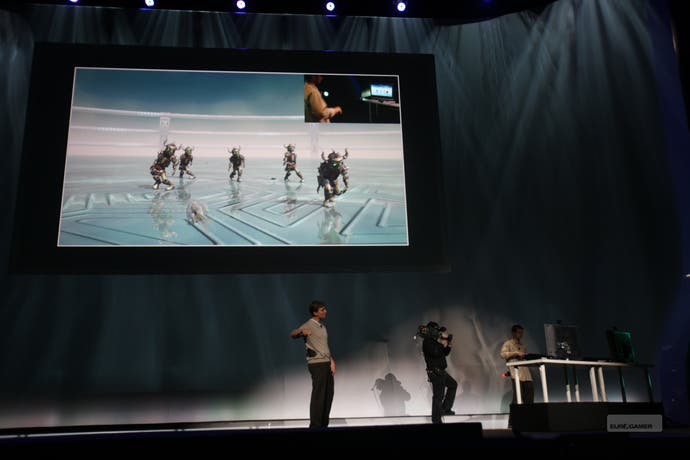Sony's new motion controller
A chat with the chaps developing it.
This year's E3 conferences were all about motion control. Apart from Nintendo's, of course, as they'd done an E3 conference about motion control several years previously and showed off Women's Murder Club instead. But Microsoft unveiled Project Natal for the first time while Sony revealed its very own motion-sensing controller, complete with PS Eye functionality and glowy coloured ball.
Kish Hirani, head of developer services, repeated part of the demo at the Develop conference in Brighton last week. Afterwards we sat down with him and SCEE's vice president of research and development, Paul Holman, to find out more.
We were warned in advance they wouldn't be able to answer questions about how much the controller will cost, when exactly it's out, whether you'll be able to draw nobs with it etc. But keep reading to find out what Hirani and Holman think about Natal and whether they're on track to meet that spring 2010 release date.
We'd already had prototypes out there in the development community for certain people, so it was more about making it real for the public. But I think the developers working on it are quite enjoying it because it adds an extra mechanic to development, an extra element and dimension to their games.

What most people are really surprised about is the precision. It's scarily good. The army has had this sort of technology for a long time, so a lot of academians have seen these things, but when you see a consumer space device with this level of accuracy - that's when developers say, 'Wow.'
Oh, totally. It's another generation forward, or even a couple of generations. I know in certain games or applications which are out there, people had to sort of fluff it to make it real for consumers. But this stuff is super-accurate and the impact of that is incredible. I think you have to play with it to realise what it will do to games.
What I personally love is to be able to write your name. Grab a mouse and write your name; it's difficult. The mouse uses very old motion-tracking technology, and to be able to write your name on the screen - that's the precision you're getting. You've physically got a chalk in your hand, you're in front of the blackboard and you're writing. That's the level of precision involved.
I think the second thing developers are picking up on is the camera aspect. There's this augmented reality where you can mix and match, take the camera input and super-impose the imagery on the game. Again, that's bringing the industry into new spaces. We'll see a lot more of that in the future, I think.
The mic is equally important. It can distinguish where you're sitting in a room, so the four of us could be sitting here and the mic could tell who's talking from where. That [technology] has previously been available, but designing your game becomes like cherry picking - grabbing what you want from these new technologies.

We haven't made developers try to learn about this new technology, struggle with it and try to make something work. We've got the libraries and we've been able to leverage work in other parts of Sony. So in the camera space, they've been doing a lot of work on facial recognition for still cameras. We've got more processing power so we can actually put it in more easily. That's where you see what people are doing in front of the camera and not just their face, but also the way their body moves and their hand gestures.
It's really about giving it to the game designers. We've got all these little things that are new and interesting and you've just got to think, 'Well, what am I going to do as a game designer?' It's going to be quite interesting to see what comes out next year.
I don't think we should be commenting on the opposition. I think that's one you want to ask some developers working on these titles, because it's not for us; it's not our style.
We're giving designers technology and training them how to use the technology. They're the ones who write the games, so I think it's only fair if you ask them.
We're proud of the technology and we think it's going to be really good, but we'll see what people do with it.

